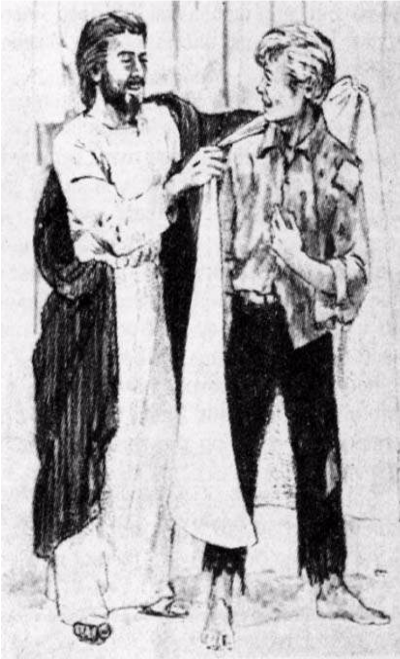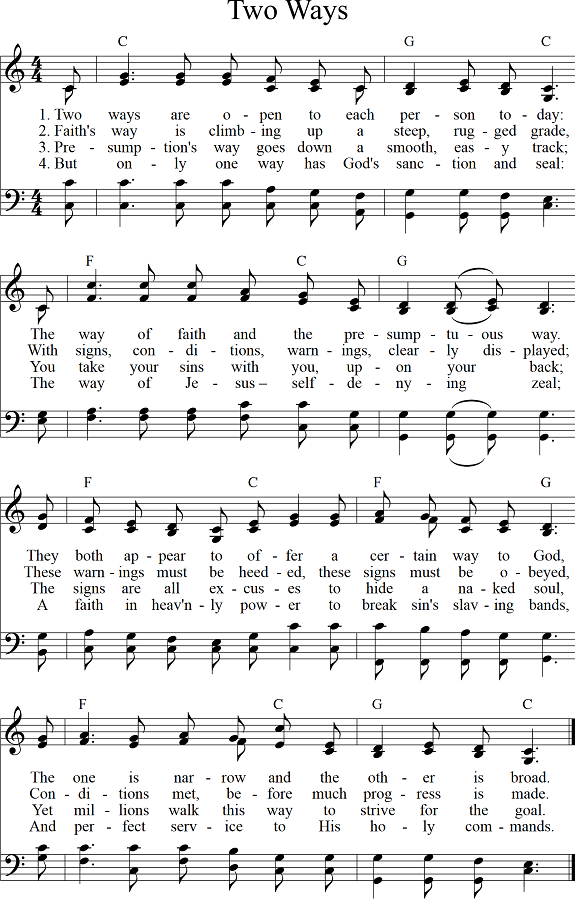For a long time we have emphasized that the difference between modern theologies all the way through the Protestant, Adventist and Brinsmead camps and our own position, is that while they teach that the old nature remains, we believe that firstly there must be the cleansing away of the old nature and then the infilling with the new. In their theology, they receive the new as a covering over the old.
Now, there appears in the Australasian Record, of August 9, 1976, the official organ of the Australasian Division of Seventh-day Adventists, an article entitled Joshua and the Angel. We cannot of course have any quarrel with the article because it is copied from the pen of inspiration. The original text can be found in Testimonies for the Church, vol. 5, p. 467 and onwards.
What does catch our attention though, is the presence in the middle of the text of an illustration in which Christ is pictured placing a beautiful white mantle around a man still wearing his very filthy garments. In another moment the man will be covered so that all that will be seen from the outside is the beautiful robe, while underneath, the dirty garments are still closest to the man.
This picture is inserted there to illustrate the message of the article, but it is the denial of what the prophet Zechariah and Ellen White wrote. The Scripture says,
Zechariah 3
4 Take away the filthy garments from him.
That is the first work done for the pleading sinner. The command cannot be misunderstood. It is impossible for this to be obeyed and, at the same time, for the filthy garments be left on the man. Yet this is precisely what the illustration portrays by leaving the original garments on him and wrapping additional garments over the dirty ones. The Scriptures then proceed to say,
Zechariah 3
4 Behold, I have caused your iniquity to pass from you, and I will clothe you with change of raiment.
There is sufficient in this sentence to make the point clear without having previously stated that the filthy garments were firstly to be taken away from him, so that he had them no more. The sufficiency is found in the words, “change of raiment.” It does not say, “I will give you an additional garment,” but that there would be a change of raiment. Everyone knows that when one changes his raiment, he firstly takes off the ones already being worn and replaces them with other clothes.
For the illustration to have been a true one of the words contained in the Scriptures, it would have shown the filthy garments being carried away by an angel, or perhaps laid in a heap at the sinner’s feet while the new garment took the place of the old. Only such a picture as this would have correctly illustrated the message of the text which reads,
Zechariah 3
4 Take away the filthy garments from him. And unto him He said, Behold, I have caused your iniquity to pass from you, and I will clothe you with change of raiment.
WHAT DOES THIS PICTURE ILLUSTRATE?
…THIS…
Zechariah 3
4 Take away the filthy garments from him. And unto him he said, Behold, I have caused your iniquity to pass from you, and I will clothe you with change of raiment.
…OR THIS…
Matthew 23
27 Woe unto you, scribes and Pharisees, hypocrites! for you are like unto whited, sepulchers, which indeed appear beautiful outward, but are within full of dead men’s bones, and of all uncleanness.
We stand amazed at the blindness manifested by the human mind once it has rejected the truth. Here is the plain text which states that the filthy garments are taken away, and right beside it an illustration purporting to accurately depict and make ever clearer the message of the article, but showing the very opposite.
We wonder how this could be, yet, there it actually is. It is truly incredible.
Not only does this article illustrate the nature of modern gospel theology, but it shows too the prevailing tendency of man to make the ways of God the same as the ways of men. In all our study of the character of God, we have seen over and again that the misconceptions of God have arisen because man thinks of God as if He were a man. When they think of God’s wrath, they think of man’s wrath; of God as a Judge, His vengeance, punishing, destroying, sending trouble and disaster and so on, they think of Him in all these things as they know man to be.
Now here in the matter of dealing with the sinfulness of man, they again have God doing what they do. This is a sin for which the Lord reproves as the Scriptures say:
Psalm 50
21 These things you have done, and I kept silence; you thought that I was altogether such a one as yourself: but I will reprove you, and set them in order before your eyes.
What is the way of man in regard to sin? His practice is to be filled with sin within and then to cover it all up with a pleasing exterior. He carefully chooses the darkness of the night and of secrecy to do his evil deeds while he represents himself as being virtuous and trustworthy without. This is the way of man and it is well known to us all. Jesus made His comment on this when He spoke thus to the Pharisees:
Matthew 23
27 Woe unto you, scribes and Pharisees, hypocrites! for you are like unto whited, sepulchers, which indeed appear beautiful outward, but are within full of dead men’s bones, and of all uncleanness.
Those Pharisees were the epitome of false religion. No better illustration for it could be found than these men. Outwardly as you looked upon them, you could see only fine clothes and manners and the representation of purity and virtue, but underneath it all was every kind of evil. That is man’s way in the world of life and religion, but it is not the way of God. When men teach that Jesus wraps His beautiful robe of righteousness to cover the evil and the deformity underneath, then men are presenting God as being the same as man in his evil ways.
Such a religious concept is to be shunned and avoided. It is not of God but of the evil one and the end thereof is death eternal.
A. T. Jones, Kansas Camp-meeting, 1889Why did the Saviour come as an infant instead of a man? To die on the cross would have met the penalty. Because He lived as a child and met all the temptations a child meets and never sinned–so that any child can stand in His place and resist in his strength; and He lived also as a youth, and as a man full grown, weaving for us a robe of righteousness to cover us (not to cover our filthy garments as that would be a mixture). He offers to take the filthy garments away and put His own in their place, so that all may have it if they will.
E. J. Waggoner, Christ and His Righteousness, p. 66Notice in the above account that the taking away of the filthy garments is the same as causing the iniquity to pass from the person. And so we find that when Christ covers us with the robe of His own righteousness, He does not furnish a cloak for sin, but takes the sin away. And this shows that the forgiveness of sins is something more than a mere form, something more than a mere entry in the books of record in heaven, to the effect that the sin has been canceled. The forgiveness of sins is a reality; it is something tangible, something that vitally affects the individual. It actually clears him from guilt; and if he is cleared from guilt, is justified, made righteous, he has certainly undergone a radical change. He is, indeed, another person. For he obtained this righteousness for the remission of sins, in Christ. It was obtained only by putting on Christ. But “if any man be in Christ, he is a new creature.” 2 Corinthians 5:17. And so the full and free forgiveness of sins carries with it that wonderful and miraculous change known as the new birth; for a man cannot become a new creature except by a new birth. This is the same as having a new, or a clean, heart.
Other articles by F. T. Wright:
- The Path of the Just
- Another Look at Acts 3:19
- Modified Improvements
- The Death of Ananias and Sapphira
- A Loving Heart
- Wheat and Tares
- The Personality of the Holy Spirit
- Point of No Return
- True Gospel Work
- Christ is Coming!
- Righteousness by Faith in the Book of Job
- The Real Issues at Minneapolis
- The Studied Care of Your Health
- Why a Detached Fourth Angel
- Men on the Moon






